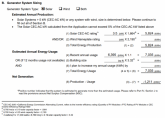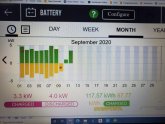Just to update this thread. I got the Skybox, and new PV panels installed and online. I had to rearrange a subpanel to become a critical loads panel, and rewire my existing PV breaker into the critical loads panel. But everything is up and running. They Skybox itself was a breeze to install (though a little heavy, get a helper!) and everything is laid out very nicely and integrated into a single unit. I am very pleased with how it came out.
I did find out that while the Skybox was originally advertised with a batteryless backup feature that allowed PV to power loads in a power outage, that
feature has since been removed. I was hoping to have some backup power while I put together my batteries, but no luck there. I have some LiFePo4 cells coming on a slow boat from China, so once those are in, I'll be in a better spot backup-wise, and will start playing with the Time of use settings and see how Skybox behaves when trying to load shift.
And to answer the question in my last post, I ended up purchasing some
generic 100A/100ma CT's from Amazon, because the Skybox has a "Custom" setting when enabling the CT option. I just set the Turns Ratio to 1000 (100A/1000=100ma). I installed the CT's at my main house panel right on the feeder wires from my utility meter. I guessed on the CT orientation, and of course they were reading power in the opposite direction the first time, so I just physically flipped them to get them reading correctly. They seem to be pretty accurate compared to the LCD display on my utility meter, within a 2-3% margin.
Since I started planning this project my expectations has been tempered a bit. I'm no longer expecting to charge my EV's on battery power, so the Skybox's 5000 watts should be plenty. With the installation of the CT's at the main breaker, I've been able to monitor my whole house's power usage in real time for the first time and it's very interesting to see the family's patterns. With COVID and work/school from home, this year is very atypical from years past, but who knows, this may be the new normal for a long time to come. I think once I get my batteries for backup and load shifting, I think I'll be in a good spot. Thanks for everyone's help and input!




